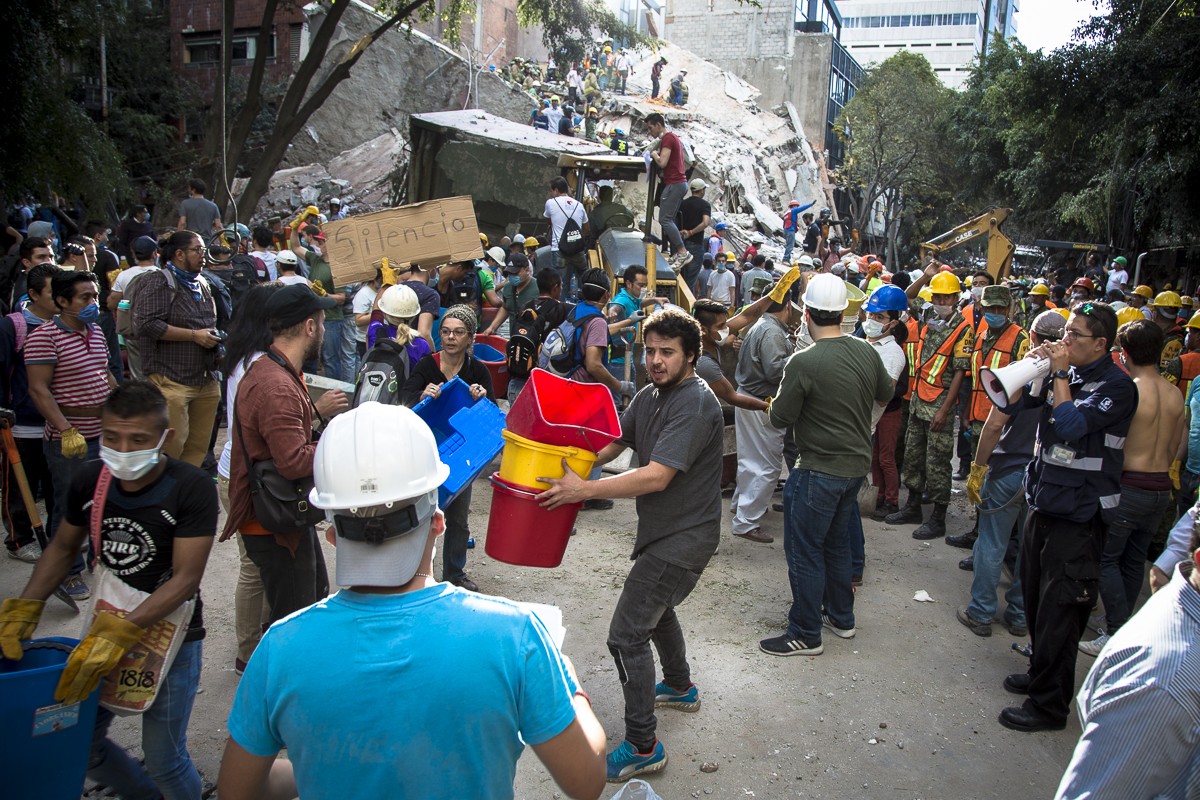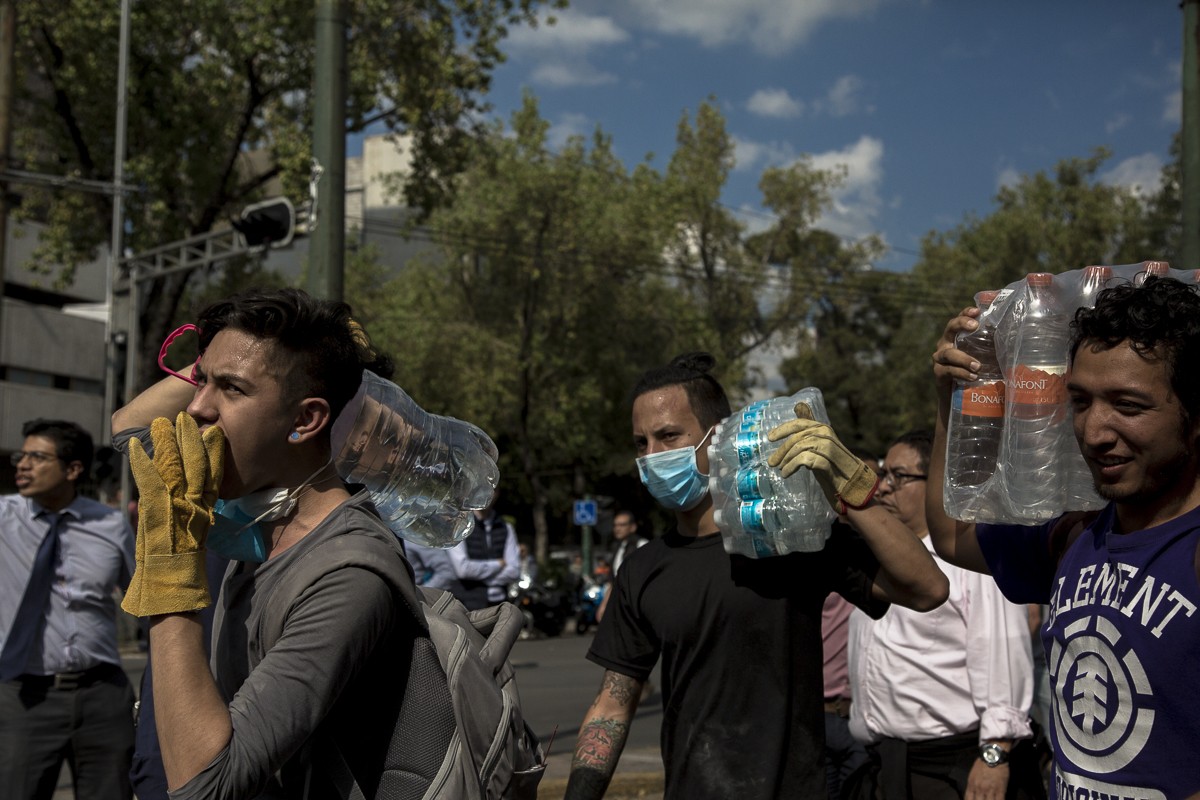Filed under: Disaster, Editorials, Featured, Mexico, Southern Mexico

On Tuesday, September 19, a powerful earthquake struck central Mexico. With a magnitude of 7.1 on the Richter scale and the epicenter just south of the city of Puebla, it has caused numerous deaths and widespread damage in Mexico City and the neighboring states of Puebla, Morelos and the State of Mexico, along with reports of loss of life and structural damage as far south and west as the states of Oaxaca and Guerrero.
#CDMX reporte de daños severos a estructuras, muchos movimientos en la ciudad tenga precaución pic.twitter.com/fIkMnpqagp
— VIGILANTE (@vigilantehuaste) September 19, 2017
Dozens of buildings collapsed in Mexico City alone and at the time of this writing at least 230 people have been reported as killed. The earthquake occurred just hours after a national earthquake drill and commemoration of the 32nd anniversary of the 1985 quake in which more than 10,000 people were killed. The 1985 tragedy is a seminal moment in modern Mexican history not only for the massive devastation caused but also due to the negligence, corruption and opportunism which marked the government’s response, especially when contrasted with the tremendous mobilization and solidarity of civil society in successfully self-organizing rescue efforts in the face of the state’s abdication of responsibility.
Tuesday’s earthquake also occurred just days after a larger, 8.1 magnitude earthquake hit off the coast of Chiapas on September 7, which led to 98 deaths and damage to tens of thousands of buildings throughout the coastal region of Chiapas and the Isthmus of Tehuantepec in Oaxaca. Days later, the area remains in crisis and all the more vulnerable as attention shifts to central Mexico.
Doloroso amanecer en #Jojutla tras #Sismo Fotos: Héctor Raúl González pic.twitter.com/FBWmDVD4jF
— Héctor Raúl González (@hectorrgonzalez) September 20, 2017
As if that were not enough, Hurricanes Katia and Max made landfall (in Veracruz and Guerrero, respectively) in the days between the two earthquakes, causing further destruction and flooding, including in areas already impacted by the first earthquake.
Though a generation in the past, the lessons from 1985 remain alive in the collective memory of civil society, as seen by the thousands who jumped into action on Tuesday after the earthquake hit. With President Enrique Peña Nieto enjoying approval ratings even lower than Trump’s, people are already well aware the state cannot be relied upon on a daily basis, so what hope is there for it to be effective in an emergency?
Cadena de humanos, en Gabriel Mancera, Del Valle. pic.twitter.com/cG6Jcm2tsn
— Alfredo Lecona (@AlfredoLecona) September 19, 2017
Anarchist crew on bikes ready with equipment to help where necessary. https://t.co/G1M1tbRwpL
— Scott Campbell (@incandesceinto) September 19, 2017
Journalist Gloria Muñoz Ramírez writes:
This part of the Cuauhtémoc district doesn’t sleep. A community kitchen was set up on Mérida street, where dozens of people arrived to prepare food for neighbors. Meanwhile, brigades of people on motorcycles, bicycles, trucks and on foot gather at donation centers and in the affected areas.
On the dark corners, groups of young people control traffic; the people thank them, bringing them coffee and food…
In a later article she observes:
At the intersection of Medellín and Viaducto, in the Roma neighborhood, there are hundreds of people on foot who are organizing those who arrive with supplies and forming rescue brigades. Groups of soldiers, police and personnel from the Mexico City government are practically following their orders, behind the housemakers preparing food and medical kits and the men organizing the distribution of shovels and picks.
People walk alongside one another carrying jugs of water, shovels, tarps, cans of tuna, lamps and medicine, while businesses open their doors for what is needed. A beauty salon with electricity offers to charge cell phones and dozens of people arrive; a hardware store offers all its wares for free, a bakery gives away its cakes and offers coffee to passers-by. People take charge of the emergency with autonomy, without waiting for someone to tell them what to do.
Meanwhile, at the National Autonomous University of Mexico (UNAM), 1,500 students gathered, along with professors of engineering, architecture and medicine and were sent out in groups throughout the city as needed and the school turned its Olympic Stadium into a donation center.
La banda libertaria se va a llevar más de 5 toneladas de víveres para Morelos. Salen a las 10 de casa de ondas.
— Alexis Añorve (@appo_stol) September 21, 2017
“The anarchist crew is going to bring over five tons of supplies to Morelos. Leaves at 10am from the Casa de Ondas.”
Social media has played a prominent role in the rescue efforts, disseminating information about which locations need assistance and which ones don’t, who is missing and who is not, what supplies are needed where, the locations of non-governmental donation centers, and what the hand gestures at rescue sites mean. They’ve also allowed individuals and organizations to offer what skills and supplies they have available, including cars, construction equipment, medical supplies, food, veterinary services, and internet access.
Muy importante seguir estas reglas:
✊?puño cerrado=Silencio
✋?palma=Nadie se mueve
☝?Dedo=sigamos trabajando
?? Necesitamos Agua#AyudaCDMX— CAMARADA EATZ ®️ (@EATZ_mx) September 20, 2017
Centros acopio NO gubernamentales, para apoyar a #CDMX #Morelos y #Puebla pic.twitter.com/NTSKksQibM
— Proyecto Ambulante (@proamboax) September 21, 2017
#SismoCDMX #Donaciones #Brigadas | Hoy en el Foro Alicia se reciben donaciones. pic.twitter.com/zUpWd76x3R
— RadioZapote (@RadioZapote) September 20, 2017
⚠️ POR FAVOR PASEN LA VOZ ⚠️ pic.twitter.com/ob1oaMWWiZ
— Comixcal (@comixcal) September 20, 2017
Naturally, the state does not look kindly upon this self-organization and has tried to reassert control. According to law, the Mexican army assumes authority during natural disasters and all relief efforts must be coordinated through it. Following the September 7 earthquake, the state sent thousands of soldiers to the Isthmus of Tehuantepec in Oaxaca, which just so happens to be a strategically important zone for capitalist development yet also one of intense resistance to that development. Instead of assisting, the army blocked off access to communities and seized relief supplies. They then handed this aid to local officials so it appeared to be coming from the government and it was distributed (or not) along political and clientelist lines, not according to need. As Griselda Sánchez writes:
In this way the army, hiding behind the mask of humanitarian aid, takes control of the situation. Fortunately, public denouncements are appearing on social media: “the army is confiscating the aid that arrives, they bring it to the storehouses of the municipal president and the [National System for Integral Family Development] DIF, who are taking everything. The aid that arrived to San Mateo from Xalapa was confiscated by soldiers; in the case of San Mateo the aid was delivered, and later it is seen in a video. But in the case of Juchitán, which is facing great problems of distribution, the army doesn’t have the capacity to deliver aid to everyone. The crisis is especially terrible there because the politicians are hoarding and setting the conditions for the delivery of aid, especially DIF which is controlled by cronies of [the dominant political party] PRI.”
Similar issues have already been coming up in Mexico City, where in one case army interference of a rescue effort likely led to the death of a person trapped in a collapsed building.
Reports from several areas that the army is not allowing volunteer rescue efforts, turned away mining experts in collapses in Escocia. https://t.co/lqtgKpNTXE
— Scott Campbell (@incandesceinto) September 20, 2017
No hay equipo de rescate pero sí armas nuevas no sea que los escombros se pongan violentos vía @proamboax pic.twitter.com/oUBpki7746
— Regeneración Radio (@regeneracion_r) September 21, 2017
“There’s no rescue equipment, but there are new weapons so the rubble doesn’t get violent.”
It also creates distracting and unnecessary tension among civil society between those who feel the army should be obeyed and others who do not. As a result, needed supplies are stranded at UNAM because the army claims it can only go through them, yet they haven’t shown up to pick it up.
Reportan: Loacopiado en la @UNAM_MX está detenido porque no ha llegado la Sedena para lucirse."Ha llegado mucha ayuda,maldita Sedena",gritan
— Proyecto Ambulante (@proamboax) September 21, 2017
It is still very early in the aftermath of this disaster. As rescue efforts continue and the scale of the loss of life and material damage becomes clearer, further obstacles from the state and opportunities for community organization will emerge. There is much healing, mourning and rebuilding ahead. Hopefully those of us observing from afar can learn and find inspiration from the autonomous actions unfolding on the ground and offer solidarity and support in return.





